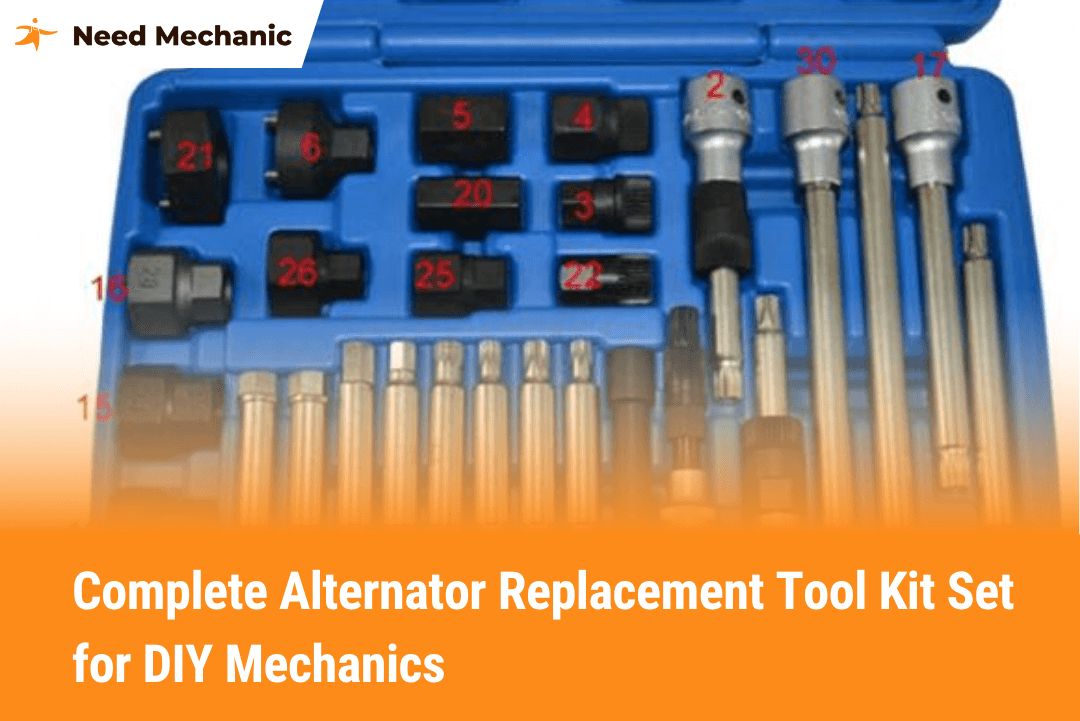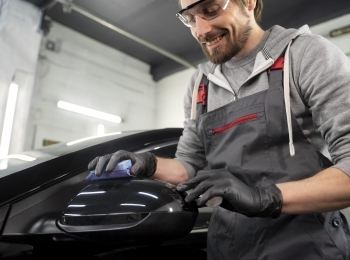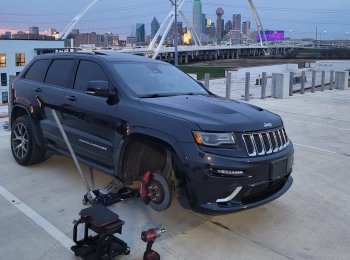The tools needed for alternator replacement include a quality socket set, ratchet wrench, serpentine belt tool, torque wrench, screwdrivers, pliers, a multimeter, and protective gear. These tools let you safely remove the old alternator, install the new one, and make sure it’s charging your battery properly.
If you’ve ever turned the key and heard only silence or seen your battery light glowing, you know how stressful alternator problems can be. The good news? With the right tools, replacing an alternator doesn’t have to be a costly, all-day repair at the shop. Having the right gear not only saves you time but also prevents damage to your car and keeps you safe while working. In this guide, you’ll get a complete breakdown of every tool you’ll need, why it matters, and how to use it. So you can tackle the job with confidence from start to finish.
Table of Contents
Why Having the Right Tools Important?
Car repairs often fail or drag on because of missing or poor-quality tools. When working on something as critical as your alternator—the component that powers your battery and electrical systems—efficiency and accuracy matter. Here’s why:
- Safety – The right tools reduce the risk of injury when dealing with electrical components or heavy parts.
- Preventing Damage – Using incorrect tools can strip bolts, break connectors, or damage nearby components.
- Saving Time – The right socket size, wrench type, or tensioner tool can turn a 3-hour struggle into a 45-minute job.
- Better Results – Correct torque settings and proper electrical connections ensure the alternator works perfectly from day one.
Basic Safety Before You Start
Before touching a single bolt, it’s important to take safety steps that apply to every alternator replacement:
- Disconnect the battery – Always remove the negative terminal first to avoid accidental short circuits.
- Park on level ground – Ensure the car is stable with the parking brake engaged.
- Allow the engine to cool – Heat can cause burns and make parts harder to remove.
- Wear safety gloves and glasses – Protect yourself from sharp edges and debris.
By following these safety steps, you set yourself up for a smoother, injury-free repair.
The Complete List of Tools Needed for Alternator Replacement
Below is the detailed breakdown of every tool you’ll likely need, along with how and why you’ll use it.
1. Socket Set (Metric and Standard Sizes)
A good-quality socket set is the backbone of alternator replacement. Most alternator mounting bolts and brackets are held in place with bolts that require sockets for removal.
Why it’s important:
- Fits snugly onto bolts for efficient removal.
- Prevents stripping and rounding off heads.
Pro tip: Look for a set that includes deep sockets for hard-to-reach bolts.
Common sizes used in alternator work:
- 10mm, 12mm, 13mm, 14mm, 15mm, and sometimes 17mm or 19mm.
2. Ratchet Wrench and Extensions
A ratchet wrench allows you to loosen and tighten bolts quickly. An extension bar helps you reach bolts located deep within the engine bay.
Why it’s important:
- Provides leverage in tight spots.
- Speeds up bolt removal compared to a standard wrench.
Pro tip: A flexible-head ratchet can make the job easier in cramped spaces.
3. Combination Wrench Set
Sometimes there’s not enough clearance for a ratchet, especially around the alternator bracket. Combination wrenches (open end on one side, box end on the other) give you more options.
Why it’s important:
- Works in areas where sockets can’t fit.
- Can loosen stubborn bolts without needing extra tools.
4. Serpentine Belt Tool or Breaker Bar
Most vehicles use a serpentine belt that needs to be loosened to remove the alternator. A belt tensioner tool or a breaker bar releases tension so you can slip the belt off.
Why it’s important:
- Prevents damage to the belt or tensioner.
- Makes reinstallation much easier.
Pro tip: Always check the belt routing diagram before removal to avoid confusion later.
5. Torque Wrench
Once the new alternator is installed, it’s important to tighten bolts to the manufacturer’s recommended torque. This prevents over-tightening (which can strip threads) or under-tightening (which can cause loosening).
Why it’s important:
- Ensures proper clamping force for safety.
- Prevents alternator movement during operation.
6. Screwdrivers (Flathead and Phillips)
Screwdrivers are needed for electrical connectors, clamps, and covers around the alternator.
Why it’s important:
- Helps remove small components without damaging them.
- Useful for prying gently in some cases.
Pro tip: Keep both short and long screwdrivers to handle various spaces.
7. Pliers (Needle-Nose and Regular)
Needle-nose pliers are great for removing small electrical clips, while standard pliers can help with hose clamps or wire crimps.
Why it’s important:
- Allows precise grip on small parts.
- Reduces risk of damaging fragile connectors.
8. Multimeter
A multimeter is essential for diagnosing electrical problems before and after alternator replacement.
Why it’s important:
- Confirms the alternator is actually faulty before replacing it.
- Tests the charging voltage after installation to ensure it’s working.
Pro tip: Healthy alternator output should be around 13.8–14.4 volts when the engine is running.
9. Pry Bar
A small pry bar can help free the alternator if it’s stuck in its bracket due to corrosion.
Why it’s important:
- Reduces the need for excessive force that could damage nearby parts.
- Makes removal faster when bolts are already out but the alternator is jammed.
10. Work Light or Headlamp
Engine bays can be dark, and good lighting helps you see exactly what you’re doing.
Why it’s important:
- Reduces mistakes from poor visibility.
- Improves efficiency during the job.
11. Protective Gloves
Gloves keep your hands safe from cuts, burns, and dirt while working around sharp or hot engine parts.
Why it’s important:
- Improves grip on tools and parts.
- Protects against battery acid or grease.
12. Battery Terminal Puller (Optional)
Sometimes battery terminals are stuck due to corrosion. A terminal puller removes them without damaging the post.
Why it’s important:
- Prevents bending or breaking battery components.
- Saves time during disconnection.
Step-by-Step Alternator Replacement Overview
While this guide focuses on tools, here’s a quick summary of the typical replacement process so you can see how each tool plays a role.
- Disconnect the battery – Using a wrench or socket.
- Loosen the belt – Using a serpentine belt tool or breaker bar.
- Remove mounting bolts – Using sockets, wrenches, and extensions.
- Disconnect wiring – Using screwdrivers and pliers.
- Remove the alternator – Pry bar if stuck.
- Install the new alternator – Position it, bolt it in, torque bolts to spec.
- Reconnect wiring and belt – Ensure belt tension is correct.
- Reconnect the battery – Test with multimeter.
Common Mistakes to Avoid
- Skipping the torque wrench – Can lead to loose alternators or damaged bolts.
- Not checking belt condition – A worn belt can fail soon after installation.
- Forgetting to disconnect the battery – This can cause dangerous electrical shorts.
- Mixing up bolts – Keep them organized during removal.
Maintenance Tips After Replacement
Once your new alternator is in place:
- Check voltage output with a multimeter regularly.
- Inspect belt tension every few weeks.
- Listen for unusual noises that might indicate loose mounting.
These habits can extend the life of your alternator and prevent repeat repairs.
Final Thoughts
Having the right tools needed for alternator replacement transforms this task from a stressful chore into a manageable DIY job. Instead of struggling with the wrong equipment, you’ll work efficiently, avoid costly mistakes, and feel confident your vehicle’s charging system is reliable again.
By preparing with the proper toolkit, you save time, protect your car’s components, and get the satisfaction of completing a professional-quality repair on your own.
FAQs
Do I really need a torque wrench for alternator replacement?
Yes, using a torque wrench is important to ensure that all mounting bolts are tightened to the manufacturer’s specifications. Over-tightening can strip threads or crack the alternator housing, while under-tightening can cause it to loosen and make noise during operation. A torque wrench ensures the correct pressure is applied, keeping the alternator secure and properly aligned. You can easily find verified professionals for the job through Need Mechanic, where experienced mechanics follow correct torque standards.
Can I replace an alternator without a serpentine belt tool?
It’s possible, but not recommended. A serpentine belt tool or breaker bar makes it much easier and safer to release tension from the belt without damaging the tensioner. Without this tool, removing the belt can be difficult and may cause misalignment during reinstallation. Investing in a proper tensioner tool helps ensure the belt stays in good condition and fits correctly afterward.
What size socket is used most for alternator bolts?
Most alternator mounting bolts use 10mm, 12mm, 13mm, 14mm, or 15mm sockets, depending on the vehicle make and model. Some larger vehicles may require 17mm or 19mm sockets. Having both metric and standard socket sets ensures you can handle any bolt size you encounter during the replacement.
Is a multimeter necessary for alternator replacement?
Yes, a multimeter is essential for diagnosing and testing. Before replacing, it confirms if the alternator is actually bad. After installation, it checks charging voltage – healthy alternators produce 13.8–14.4 volts with the engine running. Without a multimeter, you may misdiagnose charging issues.
Can I use regular pliers instead of needle-nose pliers during alternator replacement?
Regular pliers can work for basic tasks, but needle-nose pliers offer better control in tight spaces and protect delicate electrical clips. Using the right pliers prevents accidental damage to connectors and wires during alternator replacement.
Should I replace the belt when changing the alternator?
It’s a good idea to inspect and possibly replace the serpentine belt during alternator replacement. If the belt shows cracks or fraying, replace it immediately. Since the belt is already off, this is the easiest time to install a new one. Experts at Need Mechanic recommend replacing it if it has over 50,000 miles of wear.
Do I need to disconnect the battery before alternator replacement?
Yes, always disconnect the battery before starting. Remove the negative terminal first to avoid electrical shorts or sparks. This simple step keeps you and your car’s electronics safe during alternator replacement.
What tools do you need for alternator replacement?
The essential tools include:
• Socket set (metric and standard)
• Ratchet wrench with extensions
• Combination wrench set
• Serpentine belt tool or breaker bar
• Torque wrench
• Screwdrivers (flathead & Phillips)
• Pliers (needle-nose & regular)
• Multimeter
• Pry bar
• Work light and safety gloves
Having these tools ensures a smooth and safe alternator replacement.
What tool do I need to check my alternator after replacement?
A digital multimeter is the main tool used to test alternator performance. Set it to measure DC voltage and place probes on the battery terminals while the engine is running. A reading between 13.8 and 14.4 volts means your alternator is charging correctly.
What is the procedure for alternator replacement?
The basic steps are:
1. Disconnect the battery (negative terminal first).
2. Loosen and remove the serpentine belt with a belt tool.
3. Remove alternator bolts and electrical connections.
4. Install the new alternator and tighten bolts to spec.
5. Reinstall the belt and reconnect the battery.
6. Test voltage output with a multimeter to confirm proper charging.
When replacing an alternator, what else should be replaced?
You should check and possibly replace:
• Serpentine belt (if cracked or worn)
• Battery terminals (if corroded)
• Electrical connectors (if damaged)
• Tensioner pulley (if weak or noisy)
Replacing these parts ensures the new alternator works efficiently and lasts longer.
How many hours does alternator replacement take?
Most alternator replacements take 1 to 3 hours, depending on the vehicle type and how easy the alternator is to access. Compact cars are quicker, while larger vehicles take longer. Most alternator replacements take 1 to 3 hours, depending on the vehicle’s design and accessibility. Compact cars are usually faster to work on, while larger engines may take longer. You can compare service times and rates from verified professionals through Need Mechanic before scheduling.
What are the four main components in an alternator?
The four main components are:
1. Rotor and Stator – Generate electrical current.
2. Voltage Regulator – Controls voltage output.
3. Diode Rectifier – Converts AC to DC power.
4. Pulley and Bearings – Help drive and stabilize the alternator.
Knowing these parts helps understand how your charging system works and what may fail over time.










Leave a Reply